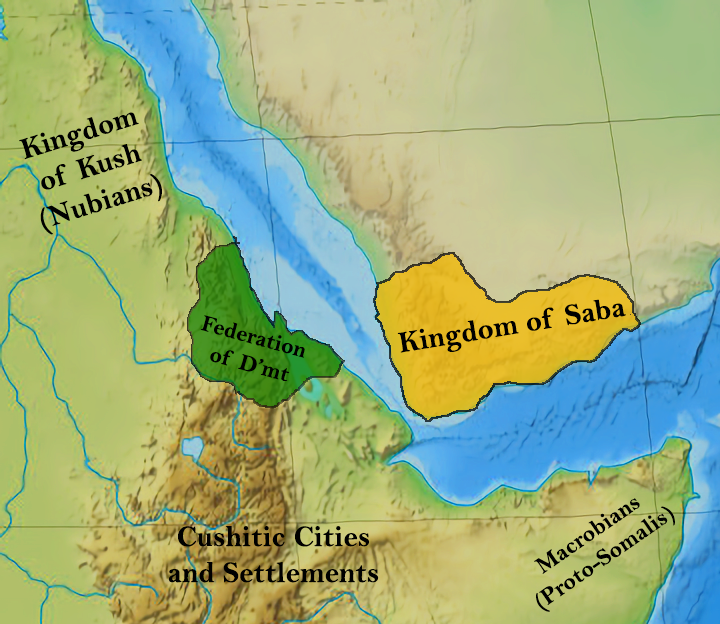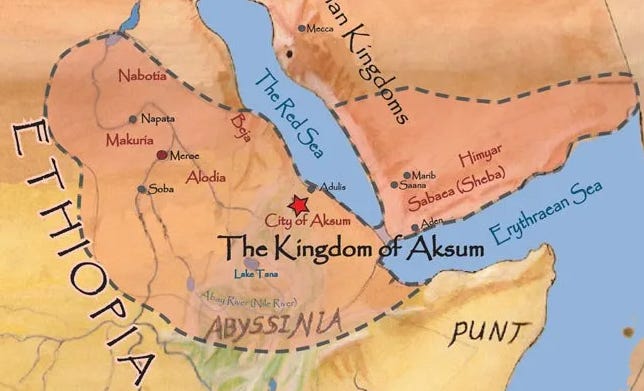Raamah (Part 2/2)
Clarifying mysterious links to India and Arabia
The earliest records for the region are around 980 BCE from what would be considered the previously discussed Kingdom of D’mt. What is most crucial regarding this Kingdom is its shared origins with the Sabaeans of Yemen, as well as dating to a time period correlating fairly close to King Solomon’s reign. There are few archeological records currently due to the lack of funding, but the oral traditions do link this Damot Kingdom to Solomon, as well as the Queen of Sheba. Other traditions in the Kingdom help attest to a shared culture with the Semitics beyond the Red Sea.
The worship of a moon god named “Ilmuqah” is shared by those across the strait in Yemen. Helping attest to this is the currently standing “Temple of Almaqah” located at the Damotian capital of Yeha.1 In fact, the ruling dynasty of the Yemeni Sabaeans regarded themselves as descended from Ilmuqah, but it is unclear if the rulers of Damot did the same. Interestingly Ilmaqah is associated as an Egyptian god2, possibly related to Ra, which may, or may not be the origin of the term “Ra’ma”. Ilmuqah’s imagery often associates him with thunderbolts which may square away with the possibility that in Hebrew “Raamah” is translated as “Thunder”, or variously meaning ‘lofty’ or ‘exalted’.
Their link to the “Sheba” in Yemen across the straits muddies the picture, but it’s clear from the close relationship between D’mt and Yemen is that there was some kind of shared origin, and mixing between their people, even if part of different lineages of Noah that sort of fuse together. Archaeologist Rodolfo Fattovich believed that there was a division in the population of Dʿmt and northern Ethiopia due to the kings ruling over the 'sb (Sabaeans) and the 'br, the 'Reds' and the 'Blacks'.3 Could it be related to the “black” Atbarah branch, and the now lost “red” nile branch at Gash, located not far from the core of D'mt territory? Would that make the ‘sb’ the “black people of Cush”, in other words including the black nilotic designation, as well as the black nubia Sab?
We do find Egyptian records separate out “Black” and “Red” Nubians showing them alongside one another, but distinctly different. In Hebrew the term for Black is actually “Sahor”, but spelled with a “Shin” rather than a “Samekh” like Sab. However this is the letter used for “Shewa”, potentially helping certify this root “sb” meaning black. We could then view “Sheba” as the “Black Ethiopians” and Raamah as the “Red Ethiopians”, or variously the Ethiopians who were closer to Egyptians, and thus “red” and worshiped similar deities to those in Egypt.
What is possible is that the oral terminology for these people was very interchangeable owing to the fact they were actually speakers of Semitic. If this was true, relating who these people were to a Hebrew audience would be quite difficult since the separation of these sounds in Ge’ez would not exist, but in Hebrew they would make a clear distinction between letters. Looking at a chart of Semitic shows that Hebrew is actually the language which retained the widest variety of “S” sounds. Specifically, in Ge’ez, the language of the Ethiopians, the Samekh and Shin were identical, and could reflect this relationship to the Hebrew terminology.
We know from the naming traditions related to African communities that color is often used for ethnic, and geographic designation. Tribes, regardless of usage of a color, may get associations with a color; a similar effect encountered to the usage of colors as directions in East Asia. We can see a notable example of this in the native name for Egypt “Kemet”, which means black, and the term for the desert regions surrounding the Nile, “Deshret”. While the color does have a purpose, relating to the black soil of the Nile and red sand of the desert, it would be sort of incorrect to call people of the Nile ‘black’ and those of the desert ‘red’. This is often what happens, and color does not necessarily imply color of a people group.
Let us return to that previous quote from Josephus: “and Ragmus the Ragmeans: and he had two sons, the one of whom, Judadas, settled the Judadeans; a nation of the western Ethiopians, and left them his name: as did Sabas, to the Sabeans”. Strange is Josephus called Dedan “Judadean” almost like the Judeans, or Judahites of Israel. Whether or not this is meant to be similar is unclear, but the next identification of Sabas is more clear when one realizes Greek doesn’t have a separate “Sh” sound and just uses S to represent the sound, even though they audibly might separate the two sounds. While one might be tempted to identify Raamah with the Kingdoms centered around Nubia and Meroe, the actual etymological and geographic descriptions certainly do not fit Raamah who likely predates the rulers of Meroe.
Now what is crucial in Raamah’s identification is the fact Josephus does correlate them to the Sabeans through his son Sheba. Historically very few scholars have made this identification but if the Sabaeans come from, or are in some way related to Raamah, that would provide a clue to Raamah’s potential geographic or ethnic designation located near his sons. This would place Raamah as a sort of proto-Ethiopic founder for both the “western Dedan-ite Ethiopians” and the Shebans of Africa as opposed to the Shebans of Yemen. However it’s unlikely Josephus knew much about the specific ethnic divisions in the region, and his identifications don’t necessarily need to be anything more than a hint towards a region for these people.
There are, however, other potential designations for Raamah outside of Ethiopia, but it’s likely these are coincidentally the result of the Alexander Effect, or simply much later designations. Oftentimes scholars have placed Raamah outside of Africa, in Arabia, but the number of Arabian sites possibly referencing Raamah is less than those in Africa. Among these identifications is the site of Ragmat in Yemen, essentially modern Najran. Najran was a major ancient location, noted in Roman sources on their way to conquer the Sabaeans. It was likely integrated into the Sabaean Kingdom sometime around 685 BCE by King Mukarrib.
Ragmat was earlier part of the Minaean Kingdom, a brother Kingdom of the Sabaeans slightly northern. Muddying this picture is the fact that located near the Ma’in capital of Qarnawu was a separate city called “RGM” in Sabaean sources. The problem with this identification is not only Ra’amah lacking a “G”, and “T” but also the fact on the opposite side of the Arabian peninsula is the city of Regmah, identified with modern Sharjah.4 A more bold connection could be made between Raamah and the Indian god “Rama”, whose name even means dark, or black. I would chalk this up to coincidence, but it cannot be ruled out completely.
Following up with this religious connection is the South Arabian epithet “Rahmanan” which means “the Merciful”. Originally a pagan term for some sort of deity, in later periods both Jews and Christians in Yemen began using this term in an attempt to displace the ancient Arabian gods. There are even inscriptions in Akkadian and Aramaic showing this title as a dedication for the god Hadad. How, or if this term is related to the previous Regmah’s is unknown, but could just as easily explain those place names, and be entirely unrelated to Raamah the son of Cush.
Continuing our search for locations rooted in Raamah we can next turn to Africa to find examples of not just cities, but this time even people associated with the term - a much stronger connection. One of Somalia’s major clans centered around the Horn of Africa are the “Rahanweyn” composed of the subtribes Digil and Mirifle. Unlike most Somali, these tribes descend from Sab directly, rather than Samaali and are considered the first Somali/Cushitic group to enter the southern regions.5 Interestingly in the Lowland Cushitic Maay Maay language spoken by the Rahanweyn their name is actually the “Reewin”. In southern Somali dialects Reewin can is usually translated as “Old Family”, with “Ree” meaning Family, and Win being Old. There is a belief this tribe was likely the first Somali tribe to enter Somali in general, attesting to their ancient origin. Could they be “Re’e-mah” of old?
Another designation for a region in the Horn of Africa during Late Antiquity was “Rauso”. A major 4th century bilingual inscription known as the Monumentum Adulitanum, dated to the reign of King Ezana, records his victories in war over a land and people named “Rauso.” While the original text was lost, in a rare circumstance this text was copied down in the 6th century by a Greek Alexandrite merchant Cosmas Indicopleustes in his impressive work of geography Christian Topography. The description simply reads: “I subjugated the peoples of Rauso who live in the midst of incense-gathering barbarians between great waterless plains”6 but helps attest to the location being accurately in the dry incense land of the Somalis. Unlike the Reewin, this tribe is less ancient and probably moved into the region after the Reewin had already migrated south.
None of these locations help us find Raamah, and merely offer contextual clues to a general location in what could be called eventual Sabaean territory. What is likely is that Sheba and Dedan both being inside Ham and Shem’s lineage may be an indication that both these people are related to the Sabaeans. A possible hint is the fact Jokshan, son of Abraham, who also has two sons named Dedan and Shewa, lacks a definitive “kingdom” or “city” named after him. Potentially linking to this theory is the fact “Ramah” is used often in the bible as a name for multiple cities in the land of Israel. The term could simply be a “royal” designation, or even a title, rather than really being any official term for an ethnic group. However, what we can say is that Raamah is most likely the earliest ‘Ethiopian’ founder, or perhaps people, predating both the Sabaeans and Aksumites, and an exact determination for the “Raamah-ite ethnicity” will require unraveling the Sheba x Dedan puzzle.
Sadly we didn’t get a great identification of Raamah, but tenuously he is the proto-Axumite/proto-Ethiopians, which will become more clear over the coming chapters. Thank you once again for reading, and hopefully you are getting a much clearer picture of Africa related to biblical history.
Stuart Munro-Hay (2002). Ethiopia: The Unknown Land. I.B. Taurus. p. 18.
Ryckmans, Jacques (1992). "South Arabia, Religion of". In Freedman, D.N. (ed.). The Anchor Bible Dictionary. Vol. 6. p. 172.
Fattovich, Rodolfo (1990). "Remarks on the Pre-Aksumite Period in Northern Ethiopia". Journal of Ethiopian Studies. 23: 17.
Third most populous city in the UAE after Dubai and Abu Dhabi.
The Invention of Somalia Page 93
Stuart Munro-Hay, Aksum: An African Civilization of Late Antiquity (Edinburgh University Press, 1991), p. 187.





